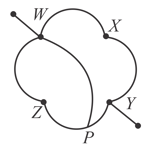Assertion: A wire of uniform cross-section and uniform resistivity is connected across an ideal cell. Now the length of wire is doubled keeping volume of wire constant. The drift velocity of electrons after stretching the wire becomes one fourth of what it was before stretching the wire.
Reason: If a wire (of uniform resistivity and uniform cross-section) of length $l_{0}$ is stretched by a factor $n,$ then its resistance becomes $n^{2}$ times the one before stretching the wire (the volume of wire is kept constant in stretching process.) Further at constant potential difference, current is inversely proportional to resistance. Drift velocity of free electron is directly proportional to current and inversely proportional to cross-sectional area of current carrying wire.
Important Questions on Current Electricity
A battery of and negligible internal resistance is connected across the diagonally opposite corners of a cubical network consisting of resistors each of resistance .
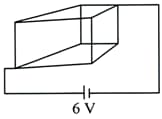
The current through the battery is
Figure shows a potentiometer used for determination of internal resistance of a cell. The balance point of the cell in the open circuit is . When a resistor of is used in the external circuit of the cell, the balance point shifts to length of the potentiometer wire. The internal resistance of the cell is
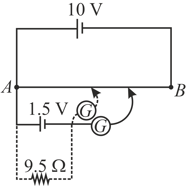
Resistors, each of value are arranged as shown in figure. The equivalent resistance between points and is

In the network shown in the figure, points , and are at potentials of , and respectively. Which of the following statements is INCORRECT?
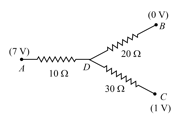
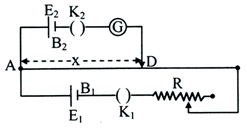
Assertion: In the potentiometer circuit shown in figure and are the e.m.f. of batteries and respectively with . Battery has negligible internal resistance. For a given value of resistor , the balance length is . If the diameter of the potentiometer wire is increased, the balance length will decrease.
Reason: At the balance point, the potential difference between due to battery the e.m.f. of battery .
A wire of resistor is bent into a circular ring of radius . Equivalent resistance between two points and on its circumference, when angle is , can be given by
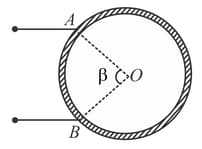
Three equal resistors, each is connected as shown in the figure. The value of for which heat generated in the circuit is maximum is
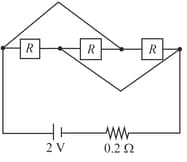
In the given mesh , each wire is uniform wire of resistance . If a wire of resistance is connected across $\mathrm{WP}$ and a constant potential difference is applied across , points and will be equipotential. Then point on placed such that
